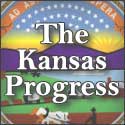What Is It About Christmas on the Plaza?

Tune in for what's new in Kansas: It's a web-based news site, and regularly published journal, dedicated to limited government in the great state of Kansas. |
![]()
© Jack Cashill
Published in ingramsonline.com - December 2012
We all received a unique Christmas gift a century ago when J.C. Nichols left this gem under our tree.
O
n a Saturday evening in early December, after watching a movie at the Plaza Cinemark, I left the adjoining parking garage and headed east on 47th Street.
Now normally, I would have turned right on Wornall and driven south to my house about a mile up the hill, but I anticipated a problem, one that most developers can only scheme about: too many pedestrians.
I was right. When the light was green on 47th Street, it was red on Wornall, and people were crossing that street in massive clusters. As I expected, the traffic backed up waiting to make the turn. I kept going straight.
There was something else unusual about these people, especially given our part of the world. They defied an easy demographic breakdown. They were neither urban nor suburban, black nor white, rich nor poor, old nor young, married nor single, Kansan nor Missourian.
Of their own accord, this miscellaneous bunch of people had somehow assembled itself into a nearly perfect sample of greater—much greater, actually—Kansas City. You will not find this kind of happy spontaneity anyplace else within a day’s drive.
Modern-Day Lessons
The question that planners need to be asking themselves is: How did this happen? How, at the turn of the last century, did a 20-something real-estate wunderkind—from Olathe, of all places—imagine this spirited Christmas-card version of urban American life and then actually put it all together?
The wunderkind in question, of course, is Jesse Clyde Nichols. For a variety of reasons, Nichols does not get quite the acclaim here he does elsewhere. Some years back, in fact, I was teaching urban studies at a French university. The textbook we were using highlighted the world’s four great planned cities. The administrators likely chose this book because one of those cities was Nancy, the site of the university in question. The other three were Paris, Bath in England, and Kansas City, Missouri. The person the book held responsible for Kansas City’s success was, of course, J.C. Nichols.
Nichols started in on the project in 1907. At the time, Brush Creek was something of a dump, literally, with a hog farm at one end of the property Nichols was assembling and a brickyard at the other.
Unlike, say, the development of the Kansas Speedway area or the redevelopment of Downtown Kansas City, Nichols’ project was short on TIF commissions, public-private partnerships, angry citizen meetings, new taxing authorities, and the brutal use of eminent domain. Nichols went about his business piece by piece, buying up swampland in 25-foot lots.
The fact that this property was beyond the reach of the streetcar lines meant that Nichols did not have to kowtow to the man that controlled them, Boss Tom Pendergast. Nichols, in fact, was creating a new Kansas City that one day would help reform the old Kansas City.
The old city, alas, was well on its way to becoming America’s most corrupt. Too many people within it depended on the Pendergast machine for too much. Those who lived and worked and shopped beyond its reaches in the Nichols’ neighborhoods to the south of the Plaza would have a freedom that those within did not.
The secret to their freedom was the automobile, and this Nichols uniquely understood. In the Country Club Plaza he created the perfect hybrid shopping area, one that I have not seen matched anywhere in America for its accommodation of both pedestrians and cars.
From the beginning, Nichols insisted on ample, free parking, and this continues to make all the difference, even today. Shoppers who come by car can shop more and longer than those who come by public transportation. This is especially true for older people. Shopping for the publicly transported must end when their arms are full.
Those who come by car can hang out all day. They can—and do—bring their children, even their babies. This can be done on public transportation, but you wouldn’t want to do it if you did not have to.
Understanding Nichols
Unlike so many suburban developers, J.C. Nichols and his then young energetic son, and successor, Miller Nichols put at least as much emphasis on the pedestrian experience. With a fondness for the cities of Spain, Seville most notably, Nichols conceived the Plaza around a Spanish theme and oversaw the execution of the concept himself. The result was a streetscape chock-a-block with graceful courtyards, fountains, sculptures, tile-adorned murals, plus lots of wrought iron, red tiles, and stucco.
Local snobs dismiss Plaza architecture as kitschy and derivative, but they misunderstand Nichols’ motives. He was imitating not just the look of a Spanish city, but the feel of it. This was a place to which people were attracted and where they felt free to linger. They still do. The Plaza remains the only area in the city where sidewalk cafés open onto a sidewalk with actual people on them. A real sidewalk café cannot overlook a parking lot.
A few Scrooges and Grinches and maybe an atheist or two sneer at the Plaza Christmas lights, a tradition that dates back to 1925. Those of us who live here can drive through the Plaza without noticing, but the lights remain a powerful draw for those who do not. To a surprising degree, they put a sense of awe and wonder back in the Christmas season.
You can sense this when you are on the streets. People shopping the Plaza on a Christmas weekend are quite simply happier than those at a suburban shopping mall. They are not running errands. They are having adventures, and they are almost inevitably sharing it with someone else.
Women dress up on the Plaza. Couples hold hands. Kids behave themselves—well, most of them, anyway. The truly unselfconscious take carriage rides. You get a sense on the Plaza of being somewhere else, somewhere special, even if you live just a mile away.


